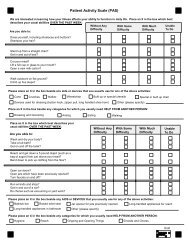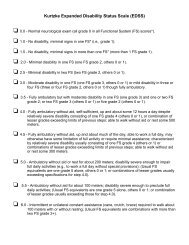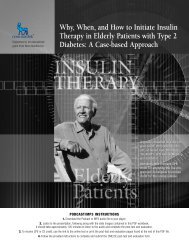Ian Smith - CMEcorner.com
Ian Smith - CMEcorner.com
Ian Smith - CMEcorner.com
Create successful ePaper yourself
Turn your PDF publications into a flip-book with our unique Google optimized e-Paper software.
Preoperative EndocrineTherapy:<br />
Appropriate Candidates<br />
<strong>Ian</strong> E. <strong>Smith</strong><br />
Royal Marsden Hospital and Institute of Cancer Research,<br />
London<br />
Royal Marsden Hospital<br />
Inst. of Cancer Research<br />
New York, October 13 th 2012<br />
How Active is Neoadjuvant Medical Therapy<br />
Clinical Response<br />
Complete Remission<br />
Path CR<br />
Chemotherapy<br />
75%<br />
30%<br />
10-50%<br />
Endocrine<br />
40-50%<br />
10%<br />
1-2%<br />
Doesn’t necessarily mean chemotherapy is better!<br />
Is There a ‘Best’ Neoadjuvant Endocrine Therapy<br />
Letrozole v Tam<br />
Anastrozole v Tam<br />
56%<br />
50<br />
50<br />
45%<br />
40<br />
36%<br />
40<br />
36%<br />
ORR (% %)<br />
30<br />
20<br />
ORR (% %)<br />
30<br />
20<br />
10<br />
10<br />
0<br />
90/162 58/162<br />
0<br />
123/276 94/259<br />
L<br />
p=0.004<br />
T<br />
A<br />
p=0.05<br />
T<br />
P-24 Eiermann et al 2001 IMPACT and PROACT <strong>Smith</strong> et al 2004
Premenopausal Neoadjuvant<br />
Endocrine Therapy for 24 Weeks<br />
Anastrozole + G* v Tamoxifen + G*<br />
100<br />
80<br />
70%<br />
P 0.004<br />
ORR (%)<br />
60<br />
40<br />
51%<br />
*goserelin<br />
20<br />
0<br />
69/98 50/99<br />
A+G<br />
T+G<br />
Masuda N et al Lancet Oncol 2012; 13: 345–52<br />
Why Use Pre-operative Systemic<br />
Therapy<br />
• To downstage to avoid mastectomy<br />
• To prolong survival<br />
• To predict out<strong>com</strong>e in adjuvant trials<br />
• To identify short term molecular markers to<br />
predict long term out<strong>com</strong>e for individual<br />
patients<br />
Neoadjuvant AI v Tamoxifen:<br />
Breast-Conserving Surgery (%)<br />
Letrozole<br />
Anastrozole<br />
50<br />
48%<br />
50<br />
46%<br />
t rate (%)<br />
Improvement<br />
40<br />
30<br />
20<br />
10<br />
36%<br />
t rate (%)<br />
Improvement<br />
40<br />
30<br />
20<br />
10<br />
22%<br />
0<br />
L T<br />
L v T: p=0.03 *<br />
0<br />
A T<br />
A v T: p=0.03 *<br />
Eiermann et al Ann Oncol 2001<br />
IMPACT <strong>Smith</strong> et al JCO 2005
Why Use Pre-operative Systemic<br />
Therapy<br />
• To downstage to avoid mastectomy<br />
• To prolong survival<br />
• To predict out<strong>com</strong>e in adjuvant trials<br />
• To identify short term molecular markers to<br />
predict long term out<strong>com</strong>e for individual<br />
patients<br />
Single-Injection Depot Progesterone Before<br />
Surgery in 976 Women With Operable Breast<br />
Cancer: A Randomized Controlled Trial<br />
Overall Survival<br />
All<br />
Node Positive<br />
HR 0.92 CI 0.69-1.21 p 0.53 HR 0.70 CI 0.49-0.99 p 0.04<br />
Badwe et al J Clin Oncol 29:2845-2851 2011<br />
Why Use Pre-operativeTherapy<br />
• To downstage to avoid mastectomy<br />
• To prolong survival<br />
• To predict out<strong>com</strong>e in adjuvant trials<br />
• To identify short term molecular markers to<br />
predict long term out<strong>com</strong>e for individual<br />
patients
Anastrozole v Tamoxifen v Combination<br />
No Correlation between Clinical Response (IMPACT)<br />
and long term out<strong>com</strong>e (ATAC)<br />
IMPACT (Neoadj)<br />
50<br />
40<br />
37%<br />
36%<br />
39%<br />
30<br />
20<br />
10<br />
Proportion event-free (%)<br />
100<br />
95<br />
90<br />
85<br />
80<br />
ATAC (Adjuvant)<br />
Anastrozole<br />
Tamoxifen<br />
Combination<br />
HR 95.2% CI P Value<br />
ANA vs TAM 0.83 0.71-0.96 0.0129<br />
Comb vs TAM 1.02 0.88-1.18 0.7718<br />
0<br />
A T C<br />
<strong>Smith</strong> et al JCO 2005<br />
0<br />
0 6 12 18 24 30 36 42<br />
Time to event (mo)<br />
IMPACT (A v Tam v Combination)<br />
% Ki67 Change from Baseline* During Treatment<br />
0<br />
Weeks<br />
2 12<br />
ATAC (Adjuvant)<br />
-10<br />
-20<br />
-30<br />
Ki67<br />
-40<br />
-50<br />
-60<br />
-70<br />
-80<br />
-90<br />
-100<br />
A v T p=0.004<br />
C v T p=0.600<br />
A v T p
Preoperative EndocrineTherapy:<br />
Appropriate Candidates<br />
How do we select who is appropriate<br />
‘Classical’ Neoadjuvant<br />
EndocrineTherapy<br />
Several months<br />
• Older patients with large ER+ve HER2-ve cancers<br />
otherwise requiring mastectomy. But…<br />
• Takes several months<br />
• Only appropriate for patients with large cancers<br />
(a minority)<br />
• pCRs very rare. Clinical endpoints soft. So how do<br />
you know CT might not also be of benefit <br />
• Age not the only parameter to select endocrine<br />
therapy<br />
Why Use Pre-operative Systemic<br />
Therapy<br />
• To downstage to avoid mastectomy<br />
• To prolong survival<br />
• To predict out<strong>com</strong>e in adjuvant trials<br />
• To identify short term molecular markers to<br />
predict long term out<strong>com</strong>e for individual<br />
patients
IMPACT: 2 Week Effect of Anastrozole on Ki67<br />
in Individual Patients<br />
Innate biology –<br />
Prognostic<br />
Ki67 (%)<br />
40<br />
30<br />
20<br />
10<br />
0<br />
0 2<br />
Weeks<br />
IMPACT: 2 Week Effect of Anastrozole on Ki67<br />
in Individual Patients<br />
Innate biology –<br />
Prognostic<br />
Ki67 (%)<br />
40<br />
30<br />
20<br />
10<br />
Biology of<br />
treatment sensitivity–<br />
Prognostic and<br />
Predictive<br />
0<br />
0 2<br />
Weeks<br />
RFS by Ki67 in IMPACT: Pre vs 2 Week<br />
2 weeks endocrine therapy<br />
Relapse Free Survival by baseline LnKi67<br />
100<br />
Relapse Free Survival by 2 week LnKi67<br />
100<br />
80<br />
80<br />
60<br />
60<br />
40<br />
40<br />
Could Short Term Pre-operative Endocrine<br />
Therapy with Molecular Markers to Predict<br />
Out<strong>com</strong>e in Individual Patients Be Feasible<br />
for Standard Practice<br />
2 weeks<br />
Molecular Markers<br />
Pre-Operative Endocrine Therapy:<br />
Individualising Care (POETIC)<br />
4000pts<br />
Postmen.<br />
HR+ve<br />
R<br />
2 weeks AI<br />
Pre- and post-surgery<br />
Standard Adjuvant<br />
Standard Adjuvant<br />
Endpoints<br />
Ki67<br />
Genes<br />
Ki67<br />
Genes<br />
RFS<br />
3600 pts so far accrued in >100 centres<br />
<strong>Smith</strong> (CI), Robertson, Dowsett<br />
PEPI (Preoperative Endocrine Prognostic Index)<br />
Based on: pT, N, ER, Ki67 after 3-4 months treatment<br />
Problem: 3 months to wait<br />
Ellis et al J Natl Cancer Inst 2008;100: 1380 – 1388
Tumor Ki67 After 4 weeks of Neoadjuvant Endocrine<br />
Therapy for Early Identification of Non-responders<br />
If High Ki67 after 4 weeks<br />
stop endocrine therapy<br />
and switch to chemotherapy<br />
Ellis et al SABCC 2009<br />
BOLERO-2 Phase 3 After an AI:<br />
Exemestane + Everolimus PFS<br />
Probability<br />
of Event (%)<br />
100<br />
80<br />
60<br />
40<br />
HR = 0.36, 95% CI (0.27, 0.47)<br />
Logrank P Value:
How Can We Predict Acquired<br />
Resistance When Planning<br />
Adjuvant Endocrine Therapy<br />
50<br />
IMPACT Ki67 (%):<br />
Individual Patient Plots on Anastrozole<br />
Proliferatio<br />
on Ki67 (%)<br />
40<br />
30<br />
20<br />
10<br />
0<br />
0<br />
2<br />
Time (weeks)<br />
12<br />
Anastrozole<br />
Dowsett et al. Clin Cancer Res 2005; 11: 951s-958s<br />
50<br />
IMPACT Ki67 (%):<br />
Individual Patient Plots on Anastrozole<br />
Proliferatio<br />
on Ki67 (%)<br />
40<br />
30<br />
20<br />
10<br />
De Novo<br />
Resistance<br />
0<br />
0<br />
2<br />
Time (weeks)<br />
12<br />
Anastrozole
50<br />
IMPACT Ki67 (%):<br />
Individual Patient Plots on Anastrozole<br />
on Ki67 (%)<br />
Proliferatio<br />
40<br />
30<br />
20<br />
10<br />
15%<br />
Acquired<br />
Resistance<br />
0<br />
0<br />
2<br />
Time (weeks)<br />
12<br />
Anastrozole<br />
IMPACT Ki67:<br />
Both De Novo and Acquired Resistance Do Badly<br />
50<br />
liferation Ki67 (%)<br />
Pro<br />
40<br />
30<br />
20<br />
10<br />
0<br />
0<br />
2<br />
Time (weeks)<br />
12<br />
Anastrozole<br />
Dowsett et al JNCI 43; 120 2011<br />
Could This Preoperative (POETIC) Model be<br />
Adapted to Predict Acquired Resistance<br />
Proliferatio<br />
on Ki67 (%)<br />
40<br />
30<br />
20<br />
10<br />
0<br />
0<br />
2<br />
Time (weeks)<br />
12<br />
AI<br />
De Novo<br />
(Chemotherapy)<br />
Acquired<br />
(mTOR inhibitor)
Conclusions (1)<br />
‘Classical’ Neoadjuvant Endocrine<br />
Therapy Is Appropriate for:<br />
Several months<br />
• Older postmenopausal patients with large strongly<br />
ER+ HER2-ve breast cancers otherwise requiring<br />
i<br />
mastectomy<br />
• Potentially many other women with ER+ HER2-ve<br />
cancers who do not need additional chemotherapy<br />
But how to select…<br />
Conclusions(2)<br />
Short Term Preoperative to Define Who Is Appropriate<br />
2-3 wks<br />
• Short term preoperative endocrine therapy could be<br />
used to define these, through post-treatment Ki67<br />
and other markers<br />
• Appropriate for most patients- not just a minority<br />
• Truly individualised therapy, by taking into account<br />
the innate sensitivity to therapy of each cancer<br />
• Can it be done as a standard of care<br />
The UK POETIC trial is first attempt<br />
Summary Slide<br />
• Neoadjuvant endocrine therapy can downstage large ER+ve HER2-ve breast<br />
cancers sufficiently to avoid mastectomy in up to 50% of postmenopausal<br />
women.<br />
• Neoadjuvant aromatase inhibitors appear more effective at this than tamoxifen<br />
• Short term preoperative endocrine therapy for around 2 weeks prior to surgery<br />
is feasible for both small and large cancers of this type, and changes in the<br />
proliferation factor Ki67 after treatment appear more accurate than pretreatment<br />
levels in predicting out<strong>com</strong>e<br />
• This approach may greatly help in making decisions about the need for<br />
additional adjuvant chemotherapy.<br />
• Unlike with standard neodjuvant therapy, this approach is appropriate for most<br />
patients- not just a minority with small cancers<br />
• It represents truly personalised medicine, by taking into account the innate<br />
sensitivity to endocrine therapy of each individual cancer<br />
• The UK POETIC trial is testing the feasibility of this hypothesis as a new<br />
standard of care in early ER+ve breast cancer, and so far almost 4000<br />
postmenopausal women have been entered







